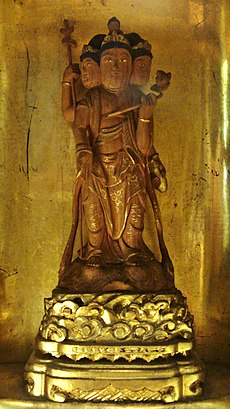Brahmā
Brahmā (T. tshang pa ཚངས་པ་; C. fantian; J. bonten 梵天) is an Indian deity who was incorporated into the Buddhist pantheon as a protector of the dharma (dharmapāla) and the ruler of the "Brahma worlds" (Brahmaloka), which are the lowest three sub-realms of the "realm of subtle form" (rupadhatu).[1]
Brahma is generally represented as a god with four faces and four arms, and his primary attributes are the lotus and the wheel (cakra).[1]
According to tradition, soon after the Buddha attained enlightenment (bodhi), Brahma (in the form of Brahma Sahampati) spoke to the Buddha and urged him to teach the dharma to others.[1][2]
According to Rupert Gethin, the term brahma is also used to denote the qualities of Brahma as a divine being.[3] Gethin states:
- ...in Buddhist texts brahma is also used to denote or describe the qualities of such divine beings; thus brahma conveys something of the sense of the English ‘divine’, something of the sense of ‘holy’ and something of the sense of 'perfection'.[3]
Peter Roberts states:
- [Brahma is] one of the primary deities of the Brahmanical pantheon, he is said to have pronounced the mantras of four vedas from each of his four faces and thus established the sonic foundation for the manifestation of the cosmos. Though not considered a creator god in Buddhist literature, in his form as Sahāṃpati Brahmā, Brahmā occupies an important place as one of two deities (the other being Indra/Śakra) that are said to have exhorted Śākyamuni to teach the Dharma in the hagiographic literature. The particular heavens over which Brahmā rules are among the most sought-after realms of higher rebirth in Buddhist literature. Among his epithets is “Lord of Sahā World” (Sahāṃpati).[4]
Forms of Brahmā
In early Buddhist texts, Brahmā is referred to by different names, possibly referring to different forms of Brahma, or to separate divinities.
Brahmā Sahampati
Brahmā Sahāmpati was the divinity who visited the Buddha when he attained enlightenment, and encouraged him to teach the Dharma to humans.[1] He resides in Mahābrahmaṇa.
Baka Brahmā
Baka Brahmā (literally "crane-Brahmā") appears in the Majjhima Nikaya, where he is a deity who believes that his world is permanent and without decay (and that therefore he is immortal), and that therefore there are no higher worlds than his.[5]
Brahmā Sanatkumāra
Brahmā Sanatkumāra (Sanskrit) or Brahmā Sanaṅkumāra (Pāli), the "Ever-young", appears in the Janavasabha-sutta (DN.18), where he is recalled as having created an illusionary presence to make himself perceptible to the coarser senses of Śakra and the gods of Trāyastriṃśa.[6]
Notes
- ↑ 1.0 1.1 1.2 1.3 Buswell & Lopez 2014, s.v. Brahmā.
- ↑ "Ayacana Sutta: The Request". www.accesstoinsight.org. Retrieved 2018-01-08.
- ↑ 3.0 3.1 Gethin 1998, s.v. Chapter 1, section "The nature of a buddha".
- ↑
 Glossary for The Ten Bhumis, s.v. "Brahma
Glossary for The Ten Bhumis, s.v. "Brahma
- ↑ "Brahma-nimantanika Sutta: The Brahma Invitation". www.accesstoinsight.org. Retrieved 2017-04-23.
- ↑ "DN 18". SuttaCentral. Retrieved 2017-04-23.
Sources
 Buswell, Robert E.; Lopez, Donald S. (2014), The Princeton Dictionary of Buddhism, Princeton University
Buswell, Robert E.; Lopez, Donald S. (2014), The Princeton Dictionary of Buddhism, Princeton University Gethin, Rupert (1998), Foundations of Buddhism, Oxford University Press
Gethin, Rupert (1998), Foundations of Buddhism, Oxford University Press
